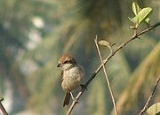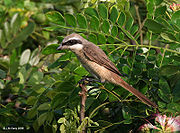
Brown Shrike
Encyclopedia
The Brown Shrike is a bird
in the shrike
family that is found mainly in Asia. It is closely related to the Red-backed Shrike
(L. collurio) and Isabelline Shrike
(L. isabellinus). Like most other shrikes, it has a distinctive black "bandit-mask" through the eye. and is found mainly in open scrub habitats, where it perches on the tops of thorny bushes in search of prey. Several populations of this widespread species form distinctive subspecies which breed in temperate Asia and migrate to their winter quarters in tropical Asia. They are sometimes found as vagrants in Europe and North America.
-_immature_in_kolkata_i_img_6072.jpg) This shrike is mainly brown on the upper parts and the tail is rounded. The black mask can be paler in winter and has a white brow over it. The underside is creamy with rufous flanks and belly. The wings are brown and lack any white "mirror" patches. Females have fine scalloping on the underside and the mask is dark brown and not as well marked as in the male. Subspecies lucionensis has a grey crown shading into the brown upperparts and the rump appears more rufous than the rest of the upperback. The tail is more brownish and not as reddish as in the Red-backed Shrike
This shrike is mainly brown on the upper parts and the tail is rounded. The black mask can be paler in winter and has a white brow over it. The underside is creamy with rufous flanks and belly. The wings are brown and lack any white "mirror" patches. Females have fine scalloping on the underside and the mask is dark brown and not as well marked as in the male. Subspecies lucionensis has a grey crown shading into the brown upperparts and the rump appears more rufous than the rest of the upperback. The tail is more brownish and not as reddish as in the Red-backed Shrike
. Younger birds of lucionensis have brown crown and lacks the grey on the head. Supspecies superciliosus has a broad white supercilium and richer reddish crown. The tail is redder and tipped in white.
A number of confusing forms are known from central Asia where the populations of cristatus, isabellinus and collurio overlap. The taxonomy has been in a state of flux and some forms such as phoenicuroides formerly considered as subspecies of L. cristatus have been moved to the species L. isabellinus.
This species is rare in Europe
and vagrants have been recorded in the USA and Canada
.
 The Brown Shrike is a migratory
The Brown Shrike is a migratory
species and ringing studies show that they have a high fidelity to their wintering sites, returning to the same locations each winter. They begin establishing wintering territories shortly on arrival and their loud chattering or rattling calls are distinctive. Birds that arrive early and establish territories appear to have an advantage over those that arrive later in the winter areas. The timing of their migration is very regular with their arrival in winter to India in August to September and departure in April. During their winter period, they go through a premigratory moult. Their song in the winter quarters is faint and somewhat resembles the call of the Rosy Starling and often includes mimicry of other birds. The beak remains closed when singing and only throat pulsations are visible although the bird moves its tail up and down while singing.
The breeding season is late May or June and the breeding habitat includes the taiga
, forest to semi-desert where they build a nest in a tree or bush, laying 2-6 eggs.
They feed on mainly on insects, especially lepidoptera. Like other shrikes, they impale prey on thorns. Small birds and lizards are also sometimes preyed on. A white-eye (Zosterops) has been recorded in its larder. They typically look out for prey from a perch and fly down towards the ground to capture them.
Bird
Birds are feathered, winged, bipedal, endothermic , egg-laying, vertebrate animals. Around 10,000 living species and 188 families makes them the most speciose class of tetrapod vertebrates. They inhabit ecosystems across the globe, from the Arctic to the Antarctic. Extant birds range in size from...
in the shrike
Shrike
Shrikes are passerine birds of the family Laniidae. The family is composed of thirty-one species in three genera. The family name, and that of the largest genus, Lanius, is derived from the Latin word for "butcher", and some shrikes were also known as "butcher birds" because of their feeding habits...
family that is found mainly in Asia. It is closely related to the Red-backed Shrike
Red-backed Shrike
The Red-backed Shrike is a carnivorous passerine bird and member of the shrike family Laniidae.English common names include 'Wariangle' and 'worrier'.-Description:...
(L. collurio) and Isabelline Shrike
Isabelline Shrike
The Isabelline Shrike is a member of the shrike family . It is the eastern equivalent of the Red-backed Shrike with which it used to be considered conspecific....
(L. isabellinus). Like most other shrikes, it has a distinctive black "bandit-mask" through the eye. and is found mainly in open scrub habitats, where it perches on the tops of thorny bushes in search of prey. Several populations of this widespread species form distinctive subspecies which breed in temperate Asia and migrate to their winter quarters in tropical Asia. They are sometimes found as vagrants in Europe and North America.
Description
-_immature_in_kolkata_i_img_6072.jpg)
Red-backed Shrike
The Red-backed Shrike is a carnivorous passerine bird and member of the shrike family Laniidae.English common names include 'Wariangle' and 'worrier'.-Description:...
. Younger birds of lucionensis have brown crown and lacks the grey on the head. Supspecies superciliosus has a broad white supercilium and richer reddish crown. The tail is redder and tipped in white.
A number of confusing forms are known from central Asia where the populations of cristatus, isabellinus and collurio overlap. The taxonomy has been in a state of flux and some forms such as phoenicuroides formerly considered as subspecies of L. cristatus have been moved to the species L. isabellinus.
Distribution
The nominate form breeds in northern Asia from Mongolia to Siberia and winters in South Asia, Myanmar and the Malay Peninsula. The race confusus described from the same region is not well marked but is said to have a wider white brow and paler upperparts and is sometimes included within the nominate population. Subspecies superciliosus (sometimes called the Japanese Shrike) breeds on the islands of Sakhalin, Kuril and Japan and winters in Hainan, Sumatra, Java, and the Sundas. Subspecies lucionensis, sometimes known as the Philippine Shrike, breeds in Korea and eastern China wintering mainly in Taiwan, Philippines but also on the Andaman Islands and in peninsular India. Suggestions that the species may breed in the Cachar Hills of Assam by E. C. Stuart Baker based on memory have been questioned.This species is rare in Europe
Europe
Europe is, by convention, one of the world's seven continents. Comprising the westernmost peninsula of Eurasia, Europe is generally 'divided' from Asia to its east by the watershed divides of the Ural and Caucasus Mountains, the Ural River, the Caspian and Black Seas, and the waterways connecting...
and vagrants have been recorded in the USA and Canada
Canada
Canada is a North American country consisting of ten provinces and three territories. Located in the northern part of the continent, it extends from the Atlantic Ocean in the east to the Pacific Ocean in the west, and northward into the Arctic Ocean...
.
Behaviour and ecology

Bird migration
Bird migration is the regular seasonal journey undertaken by many species of birds. Bird movements include those made in response to changes in food availability, habitat or weather. Sometimes, journeys are not termed "true migration" because they are irregular or in only one direction...
species and ringing studies show that they have a high fidelity to their wintering sites, returning to the same locations each winter. They begin establishing wintering territories shortly on arrival and their loud chattering or rattling calls are distinctive. Birds that arrive early and establish territories appear to have an advantage over those that arrive later in the winter areas. The timing of their migration is very regular with their arrival in winter to India in August to September and departure in April. During their winter period, they go through a premigratory moult. Their song in the winter quarters is faint and somewhat resembles the call of the Rosy Starling and often includes mimicry of other birds. The beak remains closed when singing and only throat pulsations are visible although the bird moves its tail up and down while singing.
The breeding season is late May or June and the breeding habitat includes the taiga
Taiga
Taiga , also known as the boreal forest, is a biome characterized by coniferous forests.Taiga is the world's largest terrestrial biome. In North America it covers most of inland Canada and Alaska as well as parts of the extreme northern continental United States and is known as the Northwoods...
, forest to semi-desert where they build a nest in a tree or bush, laying 2-6 eggs.
They feed on mainly on insects, especially lepidoptera. Like other shrikes, they impale prey on thorns. Small birds and lizards are also sometimes preyed on. A white-eye (Zosterops) has been recorded in its larder. They typically look out for prey from a perch and fly down towards the ground to capture them.

